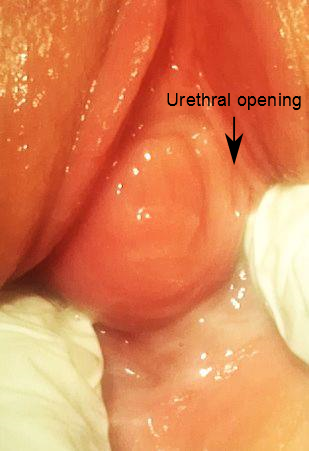Skene's gland

Skene's gland
In female human anatomy, Skene's glands or the Skene glands (/skiːn/ SKEEN; also known as the lesser vestibular glands, paraurethral glands,[1] or homologous female prostate) are glands located on the anterior wall of the vagina, around the lower end of the urethra. They secrete a fluid that helps lubricate the urethral opening, and are surrounded with tissue that swells with blood during sexual arousal.
Structure and function
The Skene's glands are located in the general area of the vulva, on the anterior wall of the vagina around the lower end of the urethra. The Skene's glands are homologous with the prostate gland in males, containing numerous microanatomical structures in common with the prostate gland, such as secretory cells.[2][3] Skene's glands are not, however, explicit prostate glands themselves. The two Skene's ducts lead from the Skene's glands to sites on the surface of the vulva, to the left and right of the urethral opening, from which they are structurally capable of secreting fluid.[2] Although there remains debate about the function of the Skene's glands, one purpose is to secrete a fluid that helps lubricate the urethral opening, possibly contributing antimicrobial factors to protect the urinary tract from infections.[3]
The origin and production site of female ejaculation has not been proven.[4] It has been postulated that the Skene's glands are the source of female ejaculation.[4][5] Because the Skene's gland and male prostate act similarly in terms of prostate-specific antigen (PSA), which is an ejaculate protein identically produced in males, and in terms of prostate-specific acid phosphatase, this led to a trend of calling the Skene's glands the female prostate.[3][5] Female ejaculate, which may emerge during sexual activity for some women, especially during female orgasm,[4] contains biochemical markers of sexual function like human urinary protein 1[6] and the enzyme PDE5, whereas women without the gland had lower concentrations of these proteins.[7] When examined with electron microscopy, the Skene's and prostate glands show similar secretory structures.[2]
It has been demonstrated that a large amount of fluid can be secreted from these glands when stimulated from inside the vagina.[8][9] Some reports indicate that embarrassment regarding female ejaculation, and the debated notion that the substance is urine, can lead to purposeful suppression of sexual climax, and lead women to seek medical advice and even undergo misadvised surgery to "stop the urine".[10]
Clinical significance

A Skene's duct cyst, pressing the urethral opening towards the right side of the image.
Disorders of or related to the Skene's gland include:
Inflammation of the Skene's glands and Bartholin glands may appear similar to cystocele.[16]
History
While the glands were first described in by the French surgeon Alphonse Guérin (1816–1895), and in 1872 by Regnier de Graaf,[17] they were named after the Scottish gynaecologist Alexander Skene, who wrote about it in Western medical literature in 1880.[18][19][20] In 2002, Skene's gland was officially renamed to female prostate by the Federative International Committee on Anatomical Terminology.[21]
See also
List of homologues of the human reproductive system
Pudendal nerve
Wolffian duct